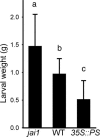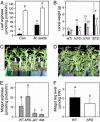Jasmonate-inducible plant enzymes degrade essential amino acids in the herbivore midgut
- PMID: 16357201
- PMCID: PMC1323180
- DOI: 10.1073/pnas.0509026102
Jasmonate-inducible plant enzymes degrade essential amino acids in the herbivore midgut
Abstract
The plant hormone jasmonic acid (JA) activates host defense responses against a broad spectrum of herbivores. Although it is well established that JA controls the expression of a large set of target genes in response to tissue damage, very few gene products have been shown to play a direct role in reducing herbivore performance. To test the hypothesis that JA-inducible proteins (JIPs) thwart attack by disrupting digestive processes in the insect gut, we used a MS-based approach to identify host proteins that accumulate in the midgut of Manduca sexta larvae reared on tomato (Solanum lycopersicum) plants. We show that two JIPs, arginase and threonine deaminase (TD), act in the M. sexta midgut to catabolize the essential amino acids Arg and Thr, respectively. Transgenic plants that overexpress arginase were more resistant to M. sexta larvae, and this effect was correlated with reduced levels of midgut Arg. We present evidence indicating that the ability of TD to degrade Thr in the midgut is enhanced by herbivore-induced proteolytic removal of the enzyme's C-terminal regulatory domain, which confers negative feedback regulation by isoleucine in planta. Our results demonstrate that the JA signaling pathway strongly influences the midgut protein content of phytophagous insects and support the hypothesis that catabolism of amino acids in the insect digestive tract by host enzymes plays a role in plant protection against herbivores.
Figures




Comment in
-
Indigestion is a plant's best defense.Proc Natl Acad Sci U S A. 2005 Dec 27;102(52):18771-2. doi: 10.1073/pnas.0509895102. Epub 2005 Dec 19. Proc Natl Acad Sci U S A. 2005. PMID: 16365286 Free PMC article. No abstract available.
References
Publication types
MeSH terms
Substances
LinkOut - more resources
Full Text Sources
Other Literature Sources

